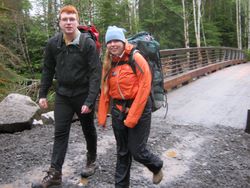It’s called “collaborative stewardship,” and planners hope to get the public involved sooner, rather than later.
Listen to iFriendly audio.
Kruzof is home to the dormant cinder cone – Mt. Edgecumbe – that looms over Sitka Sound, but there’s a lot more to this island than scenery: there’s the volcanic field itself, the black sand beaches, some of the region’s most productive salmon fishing just off shore, giant stands of timber, and unfortunately, a lot of damage.
“Like a lot of places that have been harvested in Southeast Alaska, Kruzof went through some clear-cutting, starting in the late 1950s through the 1970s. There wasn’t a lot of thought put toward salmon.”
Chris Leeseberg is a biologist with the Sitka Ranger District.
“We have some stream issues out there. We have some forest stands that are approaching what we call exclosure stage. So we’re looking at potentially doing some wildlife treatments to help the understory development. We’re looking at doing some stream restoration to restore some salmon habitat. On top of that we have a huge recreational component. There’s a lot of people from Sitka who like to go out there and use the old logging roads for ATV’ing, and we’d like to include that in our potential work out there.”
Kruzof Island is a prime candidate for forest restoration, a strategy for rebuilding the forest economy developed early in President Obama’s first term. Restoration requires finding and involving partners in developing projects, and it’s easier said than done. Ray Friedlander, with the Sitka Conservation Society, says a stakeholder group first organized in 2009 to look at biomass energy prospects on Kruzof, and didn’t get very far.
“But they came together and realized there was a disconnect between what the public was seeing and communication with the Forest Service. So it almost felt like there were these bubbles, and no dialog happening between them. So the collaborative stewardship group came together to work with all of the stakeholders in Sitka to make conversation happen.”
Collaborative stewardship is more of a process than an entity. The objective is to foster discussion around forest projects that have the long-term sustainability of the community in mind. It’s taken a while to get to this point. Andrew Thoms, the executive director of the Sitka Conservation Society, remember when things were quite different.
“You know I think back a decade ago and people in Sitka were protesting against the Forest Service for not listening to their comments. Putting on street theater in front of the Forest Service building, tearing up the written comments that they had submitted. Now we’re at a point where the Forest Service really wants input, and wants to know how do you want to see your public lands managed, what are priorities for you, how do you benefit from this landscape and our work, how can we better work together to prioritize this stuff.”
Right now, there are no bad ideas for Kruzof. The Forest Service’s Leeseberg says that the agency is interested in getting the public thinking about what work should be done on the island, before the collaborative planning process formally starts with a meeting on January 16 of next year.
He says that some possibilities are already on the table.
“One idea that’s been proposed is a bear viewing area in Iris Meadows, and through the collaborative group I’ve learned that there’s interest in that.”
Once projects have been identified, the Forest Service’s traditional planning process kicks in: projects have to be vetted with the National Environmental Policy Act (NEPA), the Tongass Forest Management Plan, and a traditional public comment period.
Leeseberg says that a relatively straightforward project like a bear-viewing area, could be reality as early as 2014.
KCAW’s Chris Todd contributed to this report.































